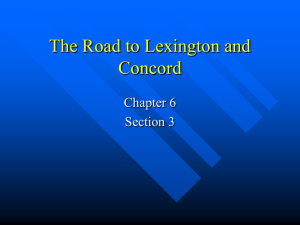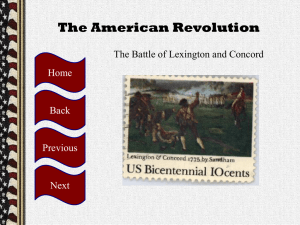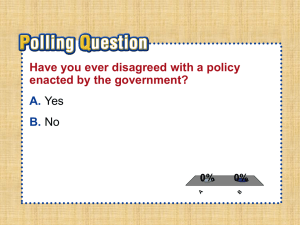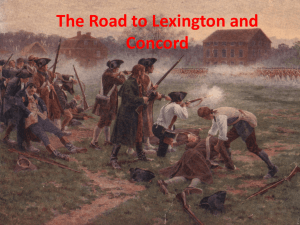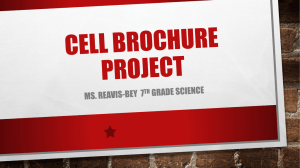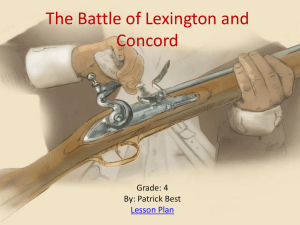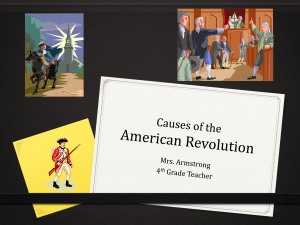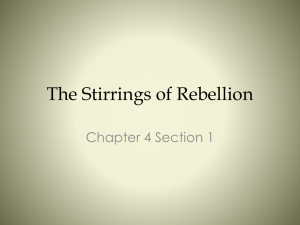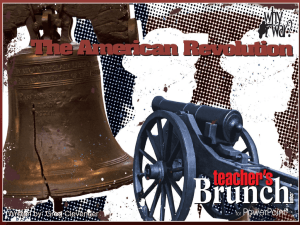Battles of Lexington and Concord
advertisement
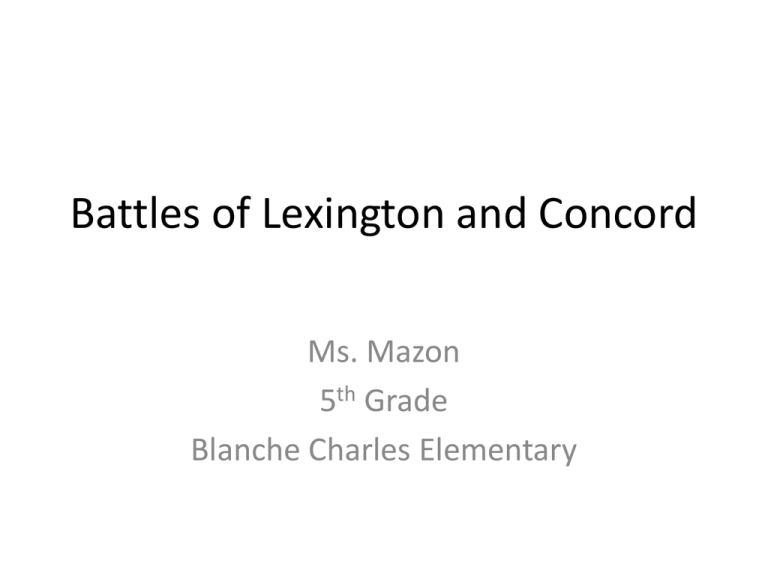
Battles of Lexington and Concord Ms. Mazon 5th Grade Blanche Charles Elementary California Social Studies Standard • 5.6 Students understand the course and consequences of the American Revolution Lesson Objective • Describe the first battle of the American Revolution Activate Prior Knowledge • Identify the Causes and Effects of the American Revolution • Graphic Organizer Vocabulary • Patriot –colonists who opposed British rule called themselves Patriots • Militia-is a group of ordinary people who train for battle Vocabulary • Minutemen-were militia • Commander – a person with special training who exercises authority, they had to be ready for chief officer, leader. battle at a minute’s notice. Vocabulary • Petition- a formally drawn request often bearing the names of number of those making the request that is addressed to a person soliciting some favor, right, mercy, or benefit Pair/Share • Turn to your partner and in your own words describe one of the vocabulary words listed War Begins • In 1775 many colonists felt that the Intolerable Acts were too harsh. There were more than 3,000 British soldiers. The British navy blocked Boston Harbor to keep ships from entering leaving Boston. Opposition • Patriots spoke out against the British government they opposed all the taxes the British were imposing. War Begins • On the night of April 18, 1775 an army of 700 British soldiers set off for Concord. Paul Revere a silversmith and William Dawes galloped ahead, alerting sleeping minutemen along the way. • British soldiers captured Revere in Lexington, but Dawes escaped. The soldiers later released Revere. • The British soldiers reached Lexington and just before sunrise on April 19, 1775 • A small group of minutemen were waiting there, a British officer told the minutemen to leave • As the minutemen turned to go, someone fired a shot. • No one knows whether the shot came from a British soldier or a colonist. • Both sides began shooting • When they stopped, eight colonists were dead and nine were wounded. Only one British soldier had been hurt. The British marched on to Concord. • As the British searched Concord for hidden weapons, more minutemen gathered nearby. • The minutemen forced the British to turn back toward Boston. “the shot heard ‘round the world” • The British soldiers were in dangerous situation on the way back. Patriots from the town between Concord and Boston, as well as towns farther north and south were ready. • As the British marched back to Boston, colonists shot at them from behind trees and stone walls. More than 250 British soldiers were wounded or killed before the British reached Boston. • News of the Battles of Lexington and Concord spread quickly more and more militias arrived in Boston. Soon thousands of armed colonists surrounded the city. • The British in Boston were trapped Guided Practice Which side had more casualties at Lexington? • What was the “shot heard round the world”? Pair/Share • Critical Thinking • How do you think colonists and militiamen felt when they heard the news of the events at the Lexington and Concord? • The Battle of Lexington and Concord which took place in Massachusetts was the start of many battles that led to the colonists’ independence from Britain. Differentiated Instruction Universal Access • Have the students draw a series of pictures to illustrate the battle of Lexington and Concord • The pictures should show events before, during, and after the battle. Independent Practice • Divide the class into two groups half the class will pretend they are British soldiers and the other half will pretend they are Patriot Soldiers and they will write a letter home describing the after mass of the Battle of Lexington and Concord Assessment • The students will design a brochure for attracting tourists to the first battle ground of the American Revolution. • Students will research major historical attractions in Boston and include them on their brochure along with pictures. Grading Rubric US STATE BROCHURE RUBRIC CATEGORY Historical Content Accuracy 4 3 2 1 All facts in the brochure are accurate and upto-date. Content relates to the state. 99-90% of the facts in the brochure are accurate. 89-80% of the facts in the brochure are accurate. A few inaccuracies evident. Fewer than 80% of the facts in the brochure are accurate. Content is not focused on the state. BROCHURE SECTIONS Required FRONT FLAP Organization of Ideas and Content Grammar and Spelling Each section in the brochure has a title cover, inside flaps, and ending flap. All required sections are included. Brochure is completely filled. Almost all sections of the brochure are present. Brochure utilizes space well. Most sections of the brochure are present. Space has some gaps. Less than half of the sections of the brochure are present. Space is not used wisely or well organized. Gaping holes are evident. -Title Cover -Name of State -State Shape Pic -Introductory Slogan -Student Name -Class & Period -Date There are no There are 1-2 grammatical or grammatical spelling mistakes. and/or spelling mistakes. There are some grammatical and/or spelling mistakes. There are several grammatical and/or spelling mistakes. INSIDE LEFT FLAP -Information -Demographics -State Facts -Economy Graphics/Pictures Sources Attractiveness & Presentation Editing and Proofreading Graphics go well with the text and there is a good mix of text and graphics. 1+ graphics per section. Graphics go well with the text, but there are so many that they distract from the text. (too many) Graphics go well with the text, but there are too few and the brochure seems "textheavy". (too few) Careful and accurate records are kept to document the source of 95100% of the facts and graphics in the brochure. (5+ sources are used and cited) Careful and accurate records are kept to document the source of 94-85% of the facts and graphics in the brochure. (At least 5 sources are cited) The brochure has exceptionally attractive formatting and well-organized information. The brochure has The brochure has attractive well-organized formatting and information. well-organized information. Documented evidence of 4 editors (2 adults and 2 students other than the author) Documented editing and proofing by 1 adult and 1 student. Graphics do not go with the accompanying text or appear to be randomly chosen. (little to no graphics) INSIDE RIGHT FLAP -Famous Locations -Weather -Education BACK FLAP -Sources Cited Careful and accurate records are kept to document the source of 84-75% of the facts and graphics in the brochure. (3 sources used and cited correctly.) Documentation of 1 person other than the author who edits and proofs the brochure. Sources are not documented accurately or are not kept on many facts and graphics. (Less than 3 sources used or cited correctly.) -Where to find more information * Optional -Little Known Facts -Unique Products -Laws & Rules The brochure's formatting and organization of material are confusing to the reader. No documentation of outside or independent editing/proofreading. -Cultural Nuances -Famous People -Current Events -Vacation Packages -Must-sees or Musthaves -Quotations & -Other Bibliography • Houghton Mifflin History Social Science United States History EDI Lesson Plan Lexington and Concord LESSON PLAN DESIGN TEMPLATE Standard & CA Standard 5.6 Students understand the course and consequences of the American revolution. C H E C K I N G Lesson Objective:Students will describe the first battles of the Ameerican Revolution. Lesson Design Context (Presentation) PHASE ONE STEP 1: Orientation to Lesson ----------- STEP 2: Preteach I DO IT F O R U N D E R S T A N D I N G Lesson Objectives Prior Skills/Advanced Organizers Language Objective Prerequisite Vocab STEP 3: Teach PHASE TWO Vocabulary/Academic Language Demonstrate, Model, Explain… Direct Delivery Meaningful Interaction Chunking & Scaffolding ----------WE DO IT STEP 4: Guided Practice PHASE THREE ----------YOU DO IT Questioning Pair Work Cooperative Learning Teacher highly involved Formal Assessment of Mastery STEP 5: Closure Written and verbal Lesson Delivery Lesson Objective: Students will describe the first battle of the Ameerican Revolution. Preteach: Identify Causes and Effects of the American Revolutions Teach: Vocabulary/Academic Language Patriot Militia Minutemen Commander Petition Demonstrate, Model, Explain the vocabulary Check for Understanding: In your own words describe one of the vocabulary words listed. Guided Practice Questioning: Which side had more causalities at Lexington? What was the “Shot heard ‘round the world”? Pair-share: Critical Thinking Discussion How do you think colonists and militiamen felt when they heard the news of the events at Lexington and Concord? Battles in Massachusetts were the beginning of the war to free colonists LESSON PLAN DESIGN TEMPLATE STEP 5: Closure C H E C K I N G STEP 6: Universal Access PHASE ONE ----------I DO IT Carefully selected based on prior instruction Tied to Objectives Differentiated Instruction * Those who need extra support F O R U N D E R S T A N D I N G Written and verbal Tied to Objective Quick Reflection/Wrap-Up PHASE TWO ----------WE DO IT PHASE THREE ----------YOU DO IT OR Battles in Massachusetts were the beginning of the war to free colonists from British rule. Quick Reflection/Wrap up: Students will complete a sequence of events chart Universal Access: Students will draw a series of pictures to illustrate the Battle of Lexington and Concord. (Pictures should show events before, during, and after the battle. Independent Students will be divided into two Practice * Those who get itgroups.One group write letters home about the Battle of Lexington and Concord from the perspective of a British soldier and the other group from the perspective of a Patriot soldier. Planning Considerations: Assessments, Questioning Level, Differentiation & EL Strategies **Modeled on eDI models, Anita Archer, SB 472 Math & ELA Models 2009
